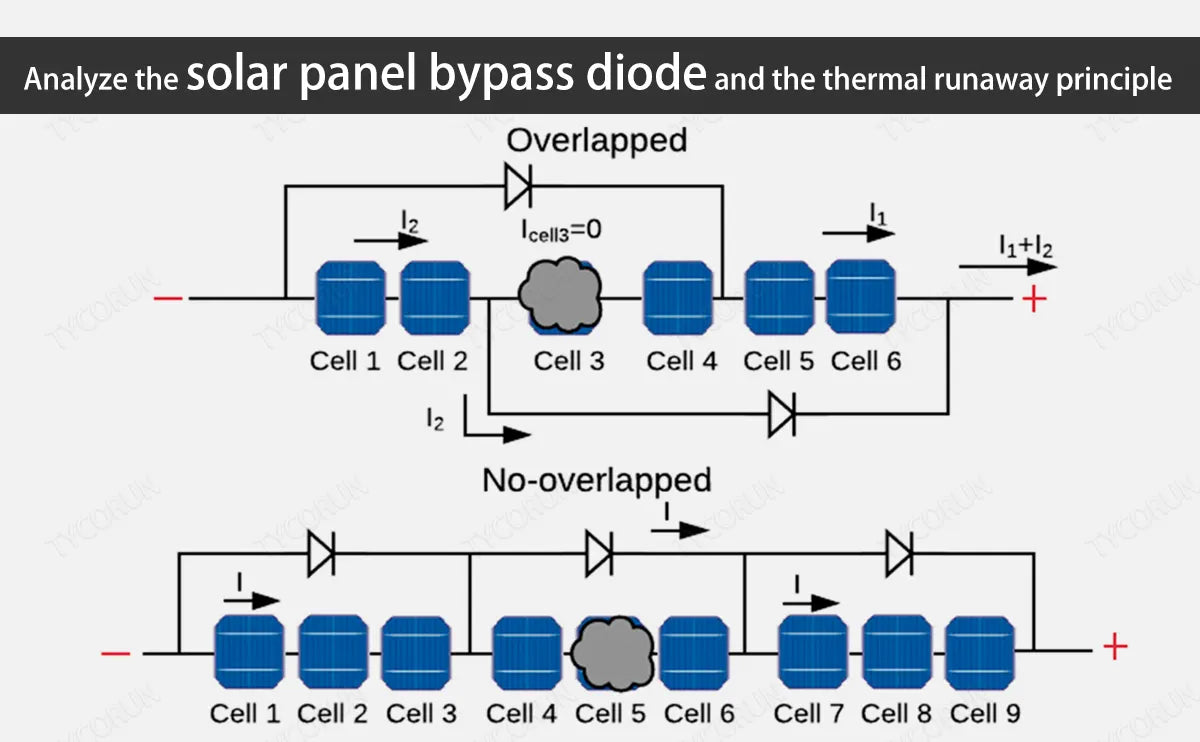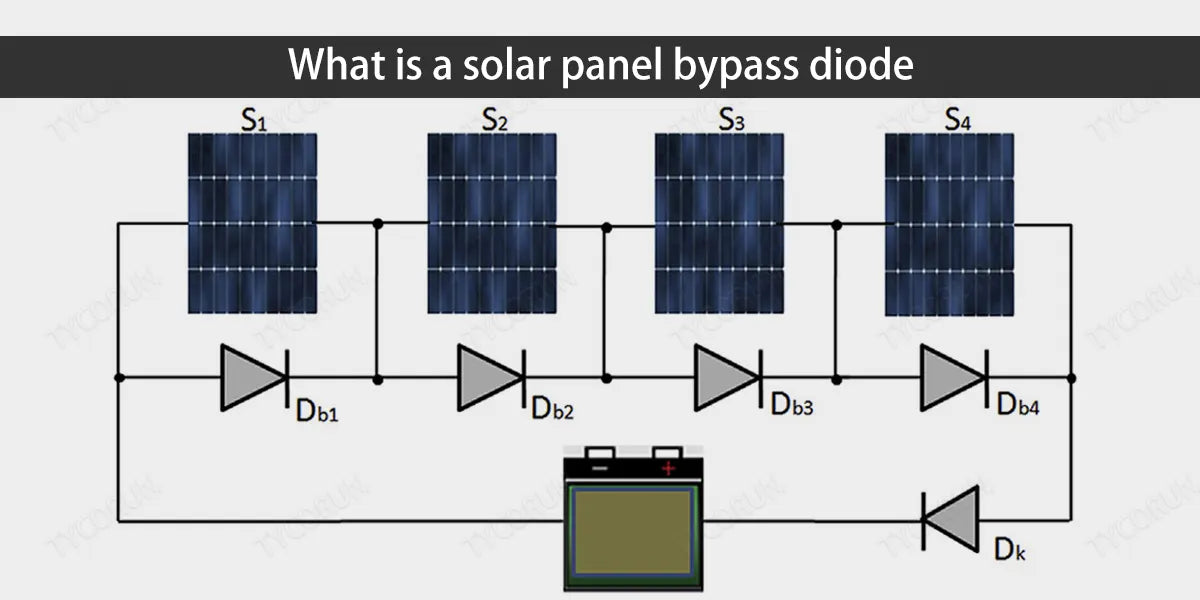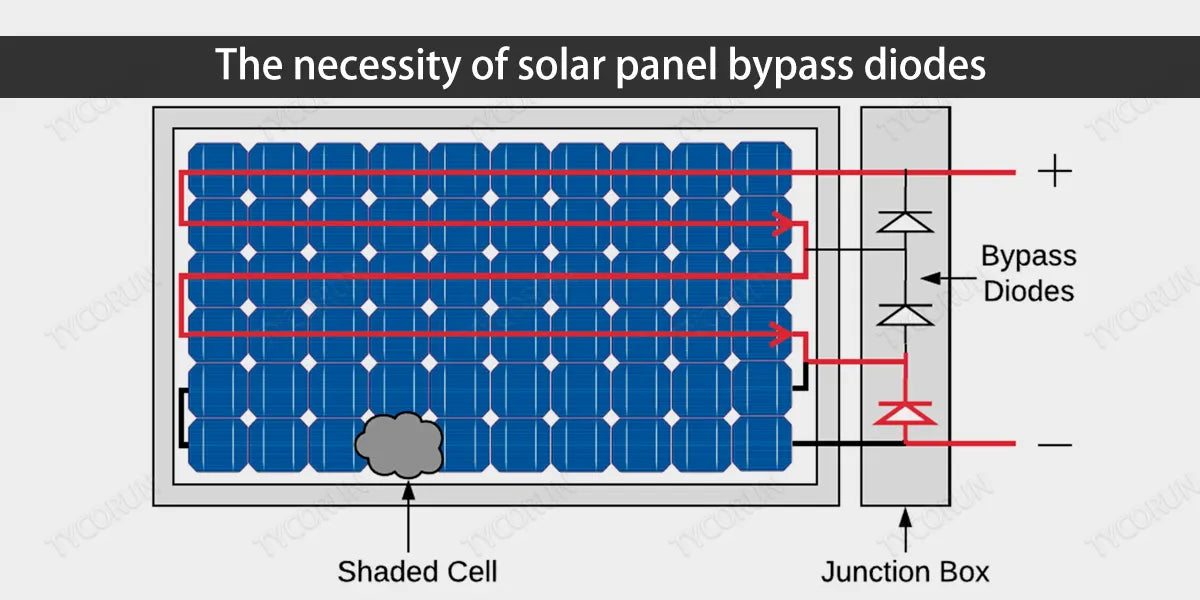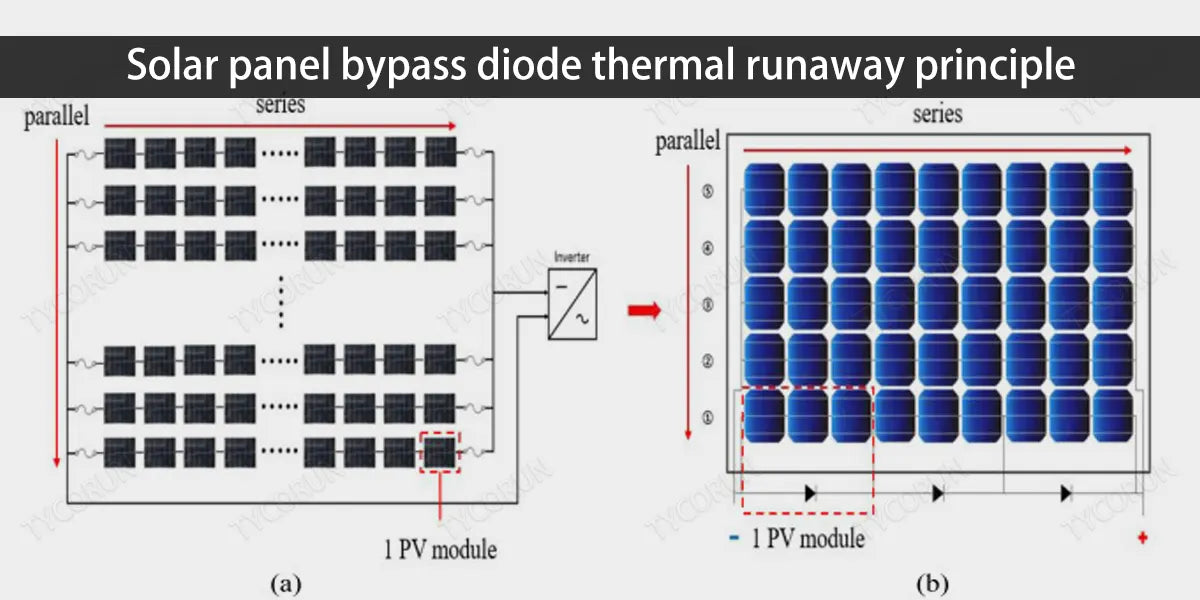
Main content:
In this article, we will learn about photovoltaic cells, solar panels, solar cell construction, photovoltaic rays, the necessity to solar panel bypass diode, the maximum power of solar panels, and more.
1. What is a solar panel bypass diode
Solar panel bypass diode is an important part of photovoltaic module. Generally, it refers to the two-terminal diodes in the solar silicon cell group that are connected in reverse parallel to the solar silicon cell group in the cell module, which can effectively prevent the silicon cell from burning due to the hot spot effect.
For example, suppose the output of a solar panel is connected to a DC battery. So, when there is light, the solar panel generates a voltage, and if that voltage is greater than the battery voltage, the battery is charged. If there is no light on the solar panel, the battery will be discharged through the solar panel.
So, in order to avoid the solar panel discharging in the dark, we have a series diode on the solar panel, and this diode is called a blocking diode. In the above circuit, the diode connected in series with the solar panel is the blocking diode.

In the above circuit, the diode that is connected in parallel with the solar panel are called solar panel bypass diode. When the solar panel is obscured or damaged, these diodes provide a separate flow path for the current.
2. The function of a solar panel bypass diode
In order to prevent solar cells from being blocked due to strong light, some of them become loads because they do not get light, and they are seriously damaged by heating.
It is generally used in bypass diodes of monocrystalline silicon and polycrystalline silicon high efficiency solar panels to protect photovoltaic cells from hot spots in the event of low and high shunt impedance. The introduction of solar bypass diodes will also lead to the multimodal characteristics of the P-U curve of the PV array under shading.
3. The necessity of solar panel bypass diodes
It is necessary to add additional elements to bypass or avoid the shading or damaged parts of the photovoltaic (photovoltaic) cell and continue to generate electricity. When photovoltaic cells are unable to generate electricity, these additional components that allow current to pass through the photovoltaic cells can be called bypass diodes.
These diodes are needed because small damage or interference to the PV module can have a significant impact on the output current. The output current can be caused by cells connected in series in the module, individual photovoltaic cells being blocked, or string modules stopping to generate electricity.

Solar panel bypass diode is very similar to those used in solar cells, allowing more current to pass through but with little loss. In general, bypass diodes are arranged in a back-biased manner between the positive and negative outputs of the solar cell and have no effect on their output.
It is desirable to have a bypass diode for each solar cell, but this is more expensive. Therefore, each group of solar cells connected in series has a diode. Bypass diodes are usually connected to several solar cells together, and no current will pass through the bypass diode while all the cells are in use without any obstruction.
Bypass diodes are very useful in special situations where the battery cannot pass current. This type of bypass diode connection prevents power loss and allows the solar battery to handle real-world problems more efficiently.
4. The effect of partial shading
The shading solar cell is unable to transfer current and voltage to the unshading cell, resulting in a decrease in the maximum power rating of the shading cell due to shading. The more light the battery mass, the more power drops. The situation is worse for a 12v 100ah lithium ion batteries with a 75% shading rate than for three batteries with a shading rate of 25%.
Unshaded cells generate a negative voltage and consume more electricity than shaded cells because they transmit more current than shaded cells. When the power output of the shading string decreases, so does the power output of the rest of the panels in the string.

The inverter circuit will try to reduce the output power, and eventually the output voltage of the battery pack will also drop beyond the inverter's operating window. In this case, a 12-volt voltage drop may occur when the battery packs are connected in series under shading conditions.
When a bypass diode is connected in parallel to a battery string connected in series, the resulting voltage drop is about 0.7 volts DC. Since the current flows through the least resistance path, the current flows through the diode, bypassing the 12 volt 200ah lithium battery in the shaded section.
However, if there is no bypass diode in the circuit, the effect of shading is even greater, because the shading solar cells generate about 12 volts of DC, so that the voltage of the solar cell module may drop to 24 volts DC.
5. Solar panel safety
The most terrible scenario for a module that doesn't have a solar panel bypass diode is that it can cause a fire, and the by-product is definitely heat. This is unlikely to happen, but it is possible under certain possible conditions. After working in shady conditions for a few days, the extra heat generated and multiple temperature cycles can cause the solar cell connector to weaken.
If the joint is weak and disconnected, there is a risk of arcing. The high temperature of the arc penetration may allow oxygen to enter the glass layer that holds the cells in the solar panels, causing the glass to explode. In this case, a highly flammable EVA that holds the glass laminate and solar cells together can catch fire. This must be avoided at all costs. Therefore, solar panel bypass diode is required.
6. Blocking diodes and bypass diodes
The physical structure is the same, but the functions are different. Blocking diodes are also known as series diodes or isolation diodes. For each solar panel connected in parallel, a blocking diode will be used. The type and size of latching diodes depends on the type of PV array.

Two types of diodes are commonly used in solar arrays as solar panel bypass diode. They are ordinary PN junction Si diodes and Schottky diodes. Both diodes have a wide range of current ratings.
Compared to ordinary PN silicon diodes, Schottky diodes are more suitable for use as bypass diodes because it has a smaller voltage drop of about 0.4V compared to 0.7V for ordinary silicon diodes. In recent years, most solar panel manufacturers have incorporated blocking diodes and bypass diodes into their solar panel designs.
7. Solar panel bypass diode thermal runaway principle
Next, we will talk about the principle of thermal runaway of solar panel bypass diode. Some solar panel bypass diodes in photovoltaic modules have the characteristic that the reverse current increases with temperature in the reverse bias state.
If it is already in a very high temperature environment when switching to reverse bias, there may be a large reverse current inside. This reverse current may cause the temperature to rise further.
When the temperature rises exceeds the heat dissipation capacity of the junction box, the temperature rises and the reverse current can cause the solar panel bypass diode to fail, which can lead to very serious consequences.

This phenomenon is known as "thermal runaway." Therefore, the thermal design of the bypass diode in the junction box of the PV module should be tested to ensure that thermal runaway does not occur.
8. Conclusion
As the application of solar power generation becomes more and more extensive, people have higher and higher requirements for the long-term durability of photovoltaic modules. Among them, solar panel bypass diode plays an important role in the performance of photovoltaic modules.
Solar panel bypass diode provides important support for the performance of photovoltaic systems. Ensuring the long-term stable operation of the system can also better understand the working status of the photovoltaic system and improve the efficiency and reliability of the system.
Related articles: silicon pv, Top 5 perovskite solar cell companies, solar panel repair
















